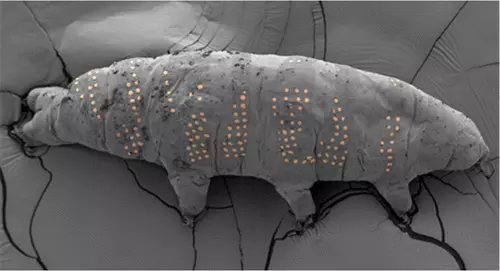
Scientists Tattoo Microscopic ‘Water Bears’
Tardigrades, also known as “water bears,” are tiny, microscopic creatures that have fascinated scientists for centuries. These eight-legged wonders are capable of surviving in extreme conditions, from freezing temperatures to boiling hot water, and even the harsh conditions of outer space. Now, scientists have taken their study of tardigrades to the next level by tattooing microscopic patterns onto these tiny critters.
Using a technique called ice lithography, researchers were able to precisely pattern dots, lines, and even a university logo onto the tardigrades’ bodies. This achievement marks a significant milestone in the field of nanofabrication and has potential applications in cryopreservation, the process of preserving living cells or tissues at very low temperatures.
Ice lithography is a unique approach that utilizes a layer of ice to create patterns on a surface. The researchers began by creating a layer of ice on a substrate, which was then exposed to a UV laser. The laser created a pattern on the ice, which was then used as a template to create a pattern on a surface. In this case, the surface was the tardigrade’s body.
The researchers were able to achieve precision patterning down to 72 nanometers, which is an impressive feat considering the size of the tardigrades. The patterns created were not only precise but also durable, surviving the harsh conditions of the tardigrades’ natural environment.
So, why would scientists want to tattoo microscopic patterns onto tardigrades? One of the main reasons is to gain a better understanding of these creatures’ remarkable resilience. Tardigrades are able to survive in extreme conditions due to their ability to enter a state of dormancy called cryptobiosis. By studying the patterns created on their bodies, researchers may be able to gain insights into the mechanisms that allow them to survive in such conditions.
Another potential application of this technique is in cryopreservation. Tardigrades’ ability to survive at very low temperatures makes them ideal subjects for studying the effects of cryopreservation on living cells. By tattooing patterns onto the tardigrades’ bodies, researchers may be able to develop new methods for preserving living cells or tissues.
The implications of this technology are vast and varied. Imagine being able to preserve human cells or organs for future transplantation or even for space travel. The potential applications of this technology are endless, and it is an exciting time for scientists and researchers in the field of cryopreservation.
In addition to the scientific implications, this technology also has the potential to advance our understanding of the natural world. By studying the intricate patterns created on the tardigrades’ bodies, researchers may be able to gain insights into the complex relationships between organisms and their environment.
The study, published in the ACS Nano Letters journal, was conducted by a team of researchers from the University of California, Los Angeles (UCLA) and the University of California, Berkeley. The researchers used a combination of techniques, including scanning electron microscopy and atomic force microscopy, to create and analyze the patterns on the tardigrades’ bodies.
In conclusion, the scientists’ ability to tattoo microscopic patterns onto tardigrades using ice lithography is a significant achievement that has potential applications in cryopreservation and our understanding of the natural world. This technology has far-reaching implications and is an exciting area of research that is sure to captivate scientists and the public alike.
Source:






